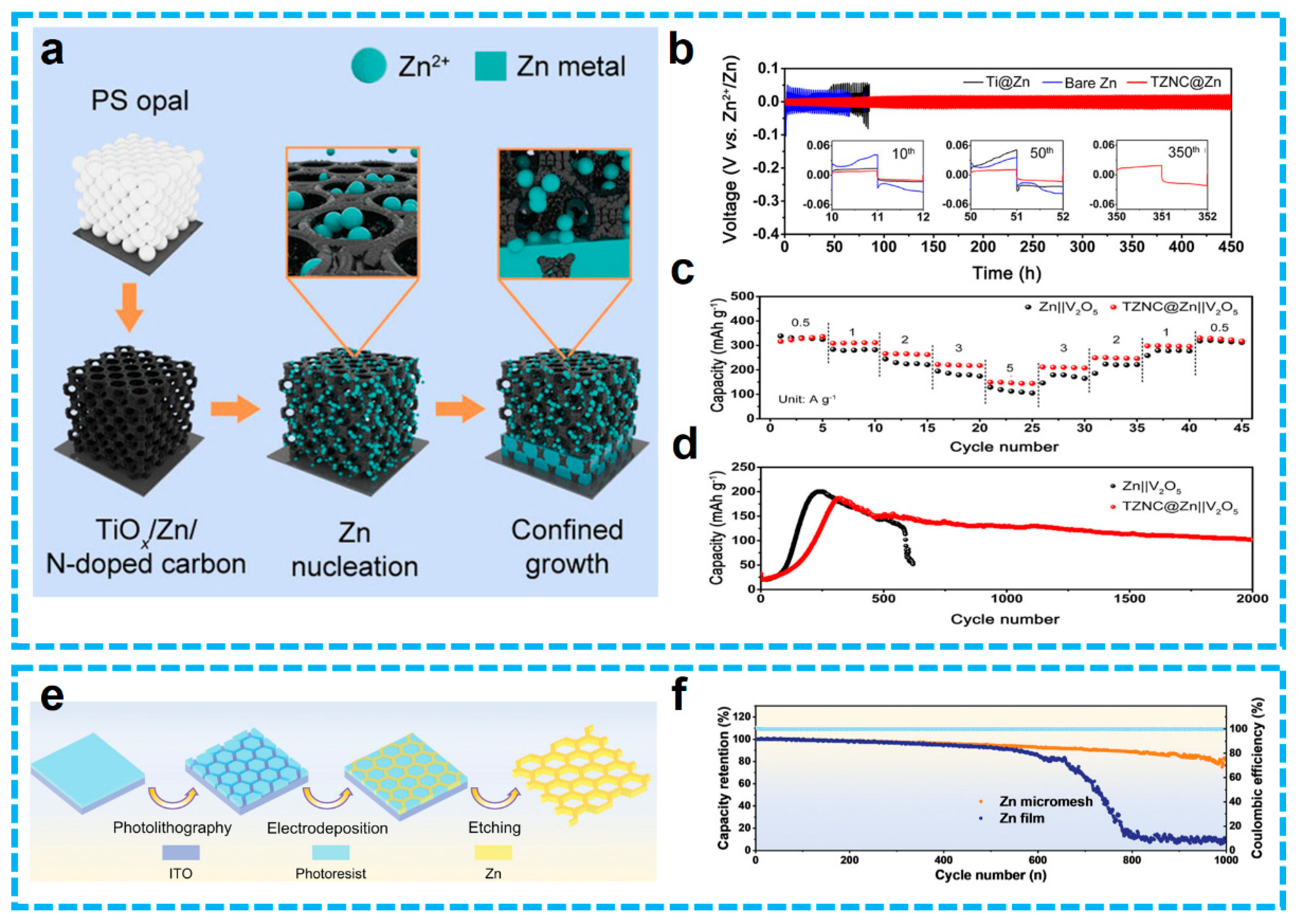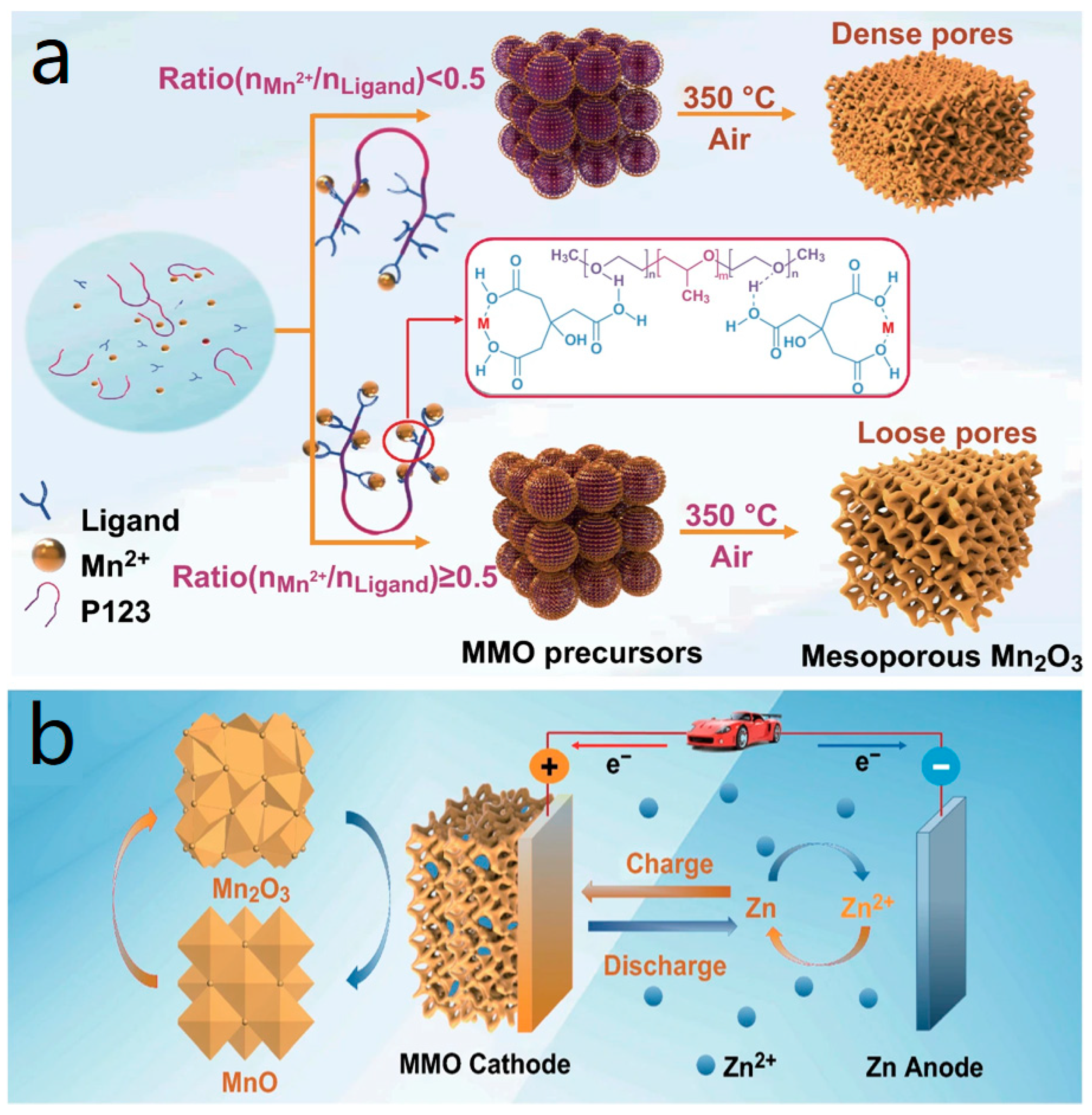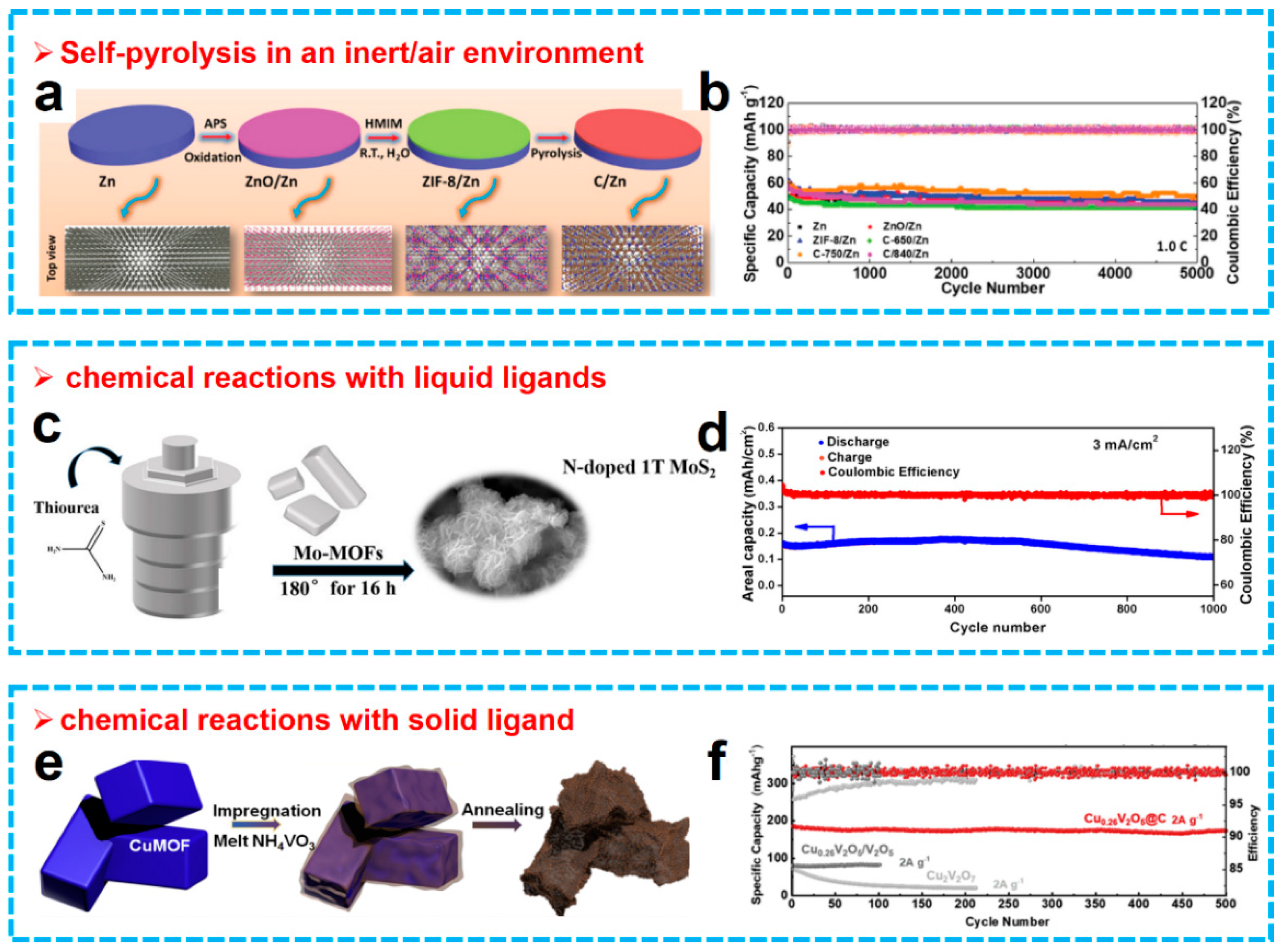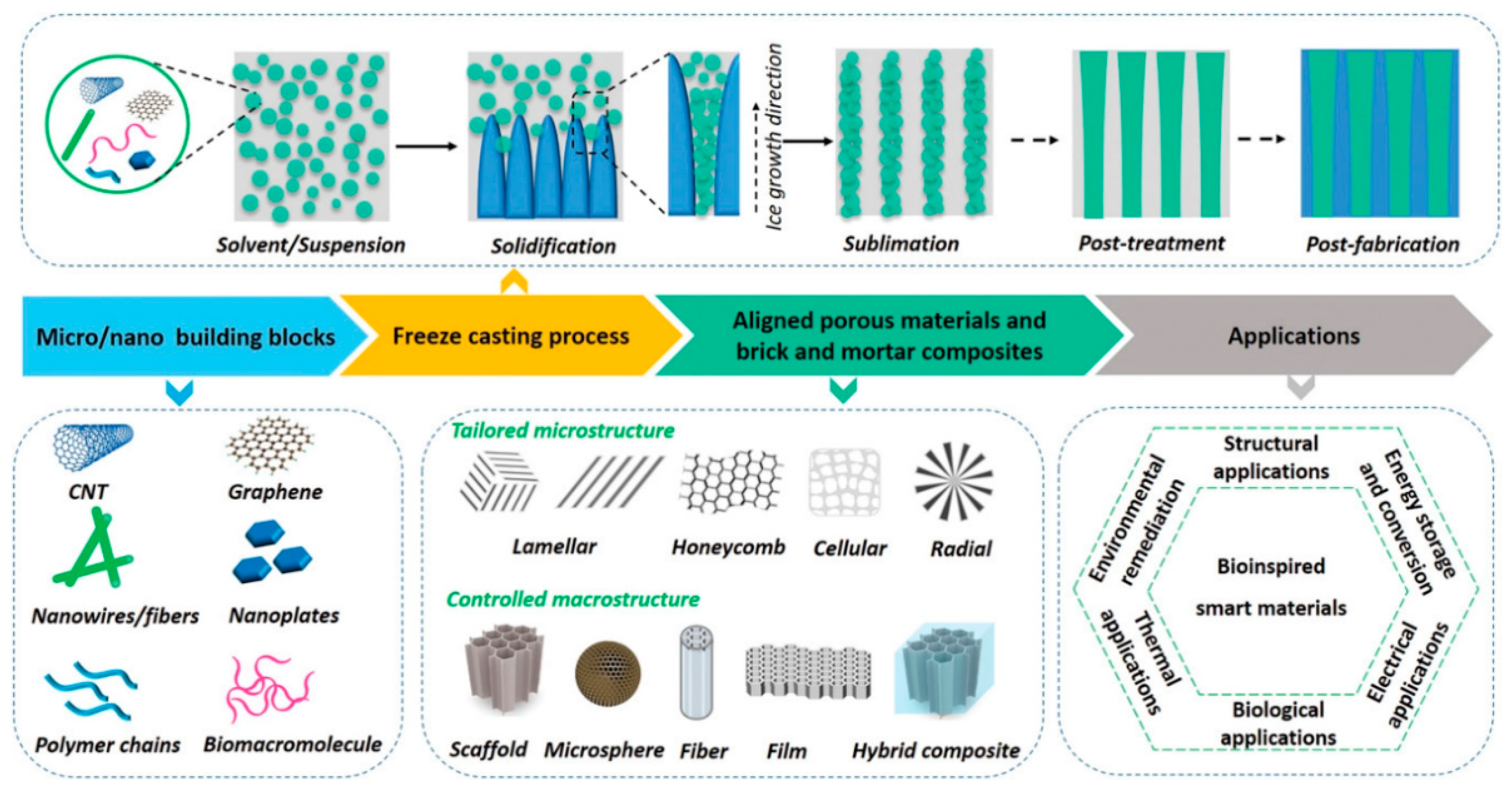Porous Electrode Materials for Zn-Ion Batteries: From Fabrication and Electrochemical Application
Abstract
:1. Introduction
2. Fabrication of Porous Electrodes for ZIB
2.1. Soft Templating of Porous Electrodes for ZIB
Porous Materials as Positive Electrode Made by Soft Templates for ZIB
2.2. Hard Templating of Porous Electrodes for ZIB
2.2.1. Inverse Opal (IO) Structures of Materials as Positive Electrode for ZIB
2.2.2. Inverse Opal (IO) Structures of Materials as Negative Electrode for ZIB

2.3. Metal-Organic Framework (MOF) Derived Porous Electrodes for ZIB
2.3.1. Porous Materials as Negative Electrode Made by MOF for ZIB
2.3.2. Porous Materials as Positive Electrode Made by MOF for ZIB
2.4. Ice Templating Porous Materials for ZIB
Porous Materials as Negative Electrode Made by Ice Templating for ZIB
2.5. Non-Templated Porous Materials for ZIB
Porous Materials as Positive Electrode Made by Non-Templated for ZIB
3. Conclusions and Perspective
Author Contributions
Funding
Data Availability Statement
Conflicts of Interest
References
- Mo, F.; Guo, B.; Liu, Q.; Ling, W.; Liang, G.; Chen, L.; Yu, S.; Wei, J. Additive manufacturing for advanced rechargeable lithium batteries: A mini review. Front. Energy Res. 2022, 10, 986985. [Google Scholar] [CrossRef]
- Hussain, I.; Lamiel, C.; Sahoo, S.; Ahmad, M.; Chen, X.; Javed, M.S.; Qin, N.; Gu, S.; Li, Y.; Nawaz, T.; et al. Factors affecting the growth formation of nanostructures and their impact on electrode materials: A systematic review. Mater. Today Phys. 2022, 27, 100844. [Google Scholar] [CrossRef]
- Li, Y.; Wu, Y.; Ma, T.; Wang, Z.; Gao, Q.; Xu, J.; Chen, L.; Li, H.; Wu, F. Long-Life Sulfide All-Solid-State Battery Enabled by Substrate-Modulated Dry-Process Binder. Adv. Energy Mater. 2022, 12, 2201732. [Google Scholar] [CrossRef]
- Xie, C.; Yan, D.; Li, H.; Du, S.; Chen, W.; Wang, Y.; Zou, Y.; Chen, R.; Wang, S. Defect chemistry in heterogeneous catalysis: Recognition, understanding and utilization. Acs Catal. 2020, 10, 11082–11098. [Google Scholar] [CrossRef]
- Liu, Q.; Ji, Z.; Mo, F.; Ling, W.; Wang, J.; Lei, H.; Cui, M.; Zhang, Z.; Liu, Y.; Cheng, L.; et al. Stable Thermochromic Hydrogel for a Flexible and Wearable Zinc-Ion Yarn Battery with High-Temperature Warning Function. ACS Appl. Energy Mater. 2022, 5, 12448–12455. [Google Scholar] [CrossRef]
- Schmidt, O.; Hawkes, A.; Gambhir, A.; Staffell, I. The future cost of electrical energy storage based on experience rates. Nat. Energy 2017, 2, 17110. [Google Scholar] [CrossRef] [Green Version]
- Liu, J.; Ahmed, S.; Wang, T.; Song, S. Flexible thermotolerant Zn-ion hybrid supercapacitors enabled by heat-resistant polymer electrolyte. Chem. Eng. J. 2023, 451, 138512. [Google Scholar] [CrossRef]
- Yang, S.; Zhang, F.; Ding, H.; He, P.; Zhou, H. Lithium metal extraction from seawater. Joule 2018, 2, 1648–1651. [Google Scholar] [CrossRef] [Green Version]
- Liu, Y.; Li, W.; Cheng, L.; Liu, Q.; Wei, J.; Huang, Y. Anti-Freezing Strategies of Electrolyte and their Application in Electrochemical Energy Devices. Chemal Rec. 2022, 22, e202200068. [Google Scholar] [CrossRef]
- Mu, Y.; Han, M.; Wu, B.; Wang, Y.; Li, Z.; Li, J.; Li, Z.; Wang, S.; Wan, J.; Zeng, L. Nitrogen, Oxygen-Codoped Vertical Graphene Arrays Coated 3D Flexible Carbon Nanofibers with High Silicon Content as an Ultrastable Anode for Superior Lithium Storage. Adv. Sci. 2022, 9, e2104685. [Google Scholar] [CrossRef]
- Mackanic, D.G.; Chang, T.-H.; Huang, Z.; Cui, Y.; Bao, Z. Stretchable electrochemical energy storage devices. Chem. Soc. Rev. 2020, 49, 4466–4495. [Google Scholar] [CrossRef] [PubMed]
- Liu, Q.; Chen, R.; Xu, L.; Liu, Y.; Dai, Y.; Huang, M.; Mai, L. Steric Molecular Combing Effect Enables Ultrafast Self-Healing Electrolyte in Quasi-Solid-State Zinc-Ion Batteries. ACS Energy Lett. 2022, 7, 2825–2832. [Google Scholar] [CrossRef]
- Liu, J.; Khanam, Z.; Ahmed, S.; Wang, T.; Wang, H.; Song, S. Flexible antifreeze zn-ion hybrid supercapacitor based on gel electrolyte with graphene electrodes. ACS Appl. Mater. Interfaces 2021, 13, 16454–16468. [Google Scholar] [CrossRef] [PubMed]
- Kundu, D.; Adams, B.D.; Duffort, V.; Vajargah, S.H.; Nazar, L.F. A high-capacity and long-life aqueous rechargeable zinc battery using a metal oxide intercalation cathode. Nat. Energy 2016, 1, 16119. [Google Scholar] [CrossRef]
- Dong, H.; Li, J.; Guo, J.; Lai, F.; Zhao, F.; Jiao, Y.; Brett, D.J.; Liu, T.; He, G.; Parkin, I.P. Insights on flexible zinc-ion batteries from lab research to commercialization. Adv. Mater. 2021, 33, 2007548. [Google Scholar] [CrossRef]
- Lv, Y.; Xiao, Y.; Ma, L.; Zhi, C.; Chen, S. Recent Advances in Electrolytes for “Beyond Aqueous” Zinc-Ion Batteries. Adv. Mater. 2022, 34, 2106409. [Google Scholar] [CrossRef]
- Zhu, Y.; Yin, J.; Zheng, X.; Emwas, A.-H.; Lei, Y.; Mohammed, O.F.; Cui, Y.; Alshareef, H.N. Concentrated dual-cation electrolyte strategy for aqueous zinc-ion batteries. Energy Environ. Sci. 2021, 14, 4463–4473. [Google Scholar] [CrossRef]
- Fang, G.; Zhou, J.; Pan, A.; Liang, S. Recent advances in aqueous zinc-ion batteries. ACS Energy Lett. 2018, 3, 2480–2501. [Google Scholar] [CrossRef]
- Blanc, L.E.; Kundu, D.; Nazar, L.F. Scientific challenges for the implementation of Zn-ion batteries. Joule 2020, 4, 771–799. [Google Scholar] [CrossRef]
- Liu, C.; Xie, X.; Lu, B.; Zhou, J.; Liang, S. Electrolyte strategies toward better zinc-ion batteries. ACS Energy Lett. 2021, 6, 1015–1033. [Google Scholar] [CrossRef]
- Ma, H.; Tian, X.; Wang, T.; Tang, K.; Liu, Z.; Hou, S.; Jin, H.; Cao, G. Tailoring Pore Structures of 3D Printed Cellular High-Loading Cathodes for Advanced Rechargeable Zinc-Ion Batteries. Small 2021, 17, 2100746. [Google Scholar] [CrossRef] [PubMed]
- Liu, P.; Gao, Y.; Tan, Y.; Liu, W.; Huang, Y.; Yan, J.; Liu, K. Rational design of nitrogen doped hierarchical porous carbon for optimized zinc-ion hybrid supercapacitors. Nano Res. 2019, 12, 2835–2841. [Google Scholar] [CrossRef]
- Wang, J.; Liu, Z.; Wang, H.-g.; Cui, F.; Zhu, G. Integrated pyrazine-based porous aromatic frameworks/carbon nanotube composite as cathode materials for aqueous zinc ion batteries. Chem. Eng. J. 2022, 450, 138051. [Google Scholar] [CrossRef]
- Fu, Y.; Wei, Q.; Zhang, G.; Wang, X.; Zhang, J.; Hu, Y.; Wang, D.; Zuin, L.; Zhou, T.; Wu, Y. High-Performance Reversible Aqueous Zn-Ion Battery Based on Porous MnOx Nanorods Coated by MOF-Derived N-Doped Carbon. Adv. Energy Mater. 2018, 8, 1801445. [Google Scholar] [CrossRef]
- Hussain, I.; Ahmad, M.; Chen, X.; Abbas, N.; Al Arni, S.; Salih, A.A.M.; Benaissa, M.; Ashraf, M.; Ayaz, M.; Imran, M.; et al. Glycol-assisted Cu-doped ZnS polyhedron-like structure as binder-free novel electrode materials. J. Saudi Chem. Soc. 2022, 26, 101510. [Google Scholar] [CrossRef]
- Wu, B.; Mu, Y.; Li, Z.; Li, M.; Zeng, L.; Zhao, T. Realizing high-voltage aqueous zinc-ion batteries with expanded electrolyte electrochemical stability window. Chin. Chem. Lett. 2022. [Google Scholar] [CrossRef]
- Liu, Q.; Yang, L.; Ling, W.; Guo, B.; Chen, L.; Wang, J.; Zhang, J.; Wang, W.; Mo, F. Organic electrochromic energy storage materials and device design. Front. Chem. 2022, 10, 1001425. [Google Scholar] [CrossRef]
- Yang, L.; Liu, Q.; Liu, Y.; Chen, X.; Luo, J.; Huang, Y. Shape-Memory Electrochemical Energy Storage Devices. Batter. Supercaps 2022, 5, 202200275. [Google Scholar] [CrossRef]
- Ren, H.; Zhao, J.; Yang, L.; Liang, Q.; Madhavi, S.; Yan, Q. Inverse opal manganese dioxide constructed by few-layered ultrathin nanosheets as high-performance cathodes for aqueous zinc-ion batteries. Nano Res. 2019, 12, 1347–1353. [Google Scholar] [CrossRef]
- Ding, Y.; Peng, Y.; Chen, S.; Zhang, X.; Li, Z.; Zhu, L.; Mo, L.-E.; Hu, L. Hierarchical porous metallic V2O3@ C for advanced aqueous zinc-ion batteries. ACS Appl. Mater. Interfaces 2019, 11, 44109–44117. [Google Scholar] [CrossRef]
- Tang, K.; Yuan, C.; Xiong, Y.; Hu, H.; Wu, M. Inverse-opal-structured hybrids of N, S-codoped-carbon-confined Co9S8 nanoparticles as bifunctional oxygen electrocatalyst for on-chip all-solid-state rechargeable Zn-air batteries. Appl. Catal. B Environ. 2020, 260, 118209. [Google Scholar] [CrossRef]
- Zhou, J.; Zhang, R.; Xu, R.; Li, Y.; Tian, W.; Gao, M.; Wang, M.; Li, D.; Liang, X.; Xie, L. Super-Assembled Hierarchical Cellulose Aerogel-Gelatin Solid Electrolyte for Implantable and Biodegradable Zinc Ion Battery. Adv. Funct. Mater. 2022, 32, 2111406. [Google Scholar] [CrossRef]
- Lu, Y. Surfactant-Templated Mesoporous Materials: From Inorganic to Hybrid to Organic. Angew. Chem. Int. Ed. 2006, 45, 7664–7667. [Google Scholar] [CrossRef] [PubMed]
- Lee, A.F.; Bennett, J.A.; Manayil, J.C.; Wilson, K. Heterogeneous catalysis for sustainable biodiesel production via esterification and transesterification. Chem. Soc. Rev. 2014, 43, 7887–7916. [Google Scholar] [CrossRef] [Green Version]
- Wang, H.; Shao, Y.; Mei, S.; Lu, Y.; Zhang, M.; Sun, J.-K.; Matyjaszewski, K.; Antonietti, M.; Yuan, J. Polymer-derived heteroatom-doped porous carbon materials. Chem. Rev. 2020, 120, 9363–9419. [Google Scholar] [CrossRef] [PubMed]
- Xie, Y.; Kocaefe, D.; Chen, C.; Kocaefe, Y. Review of research on template methods in preparation of nanomaterials. J. Nanomater. 2016, 2016, 2302595. [Google Scholar] [CrossRef] [Green Version]
- Feng, D.; Gao, T.-N.; Zhang, L.; Guo, B.; Song, S.; Qiao, Z.-A.; Dai, S. Boosting high-rate zinc-storage performance by the rational design of Mn2O3 nanoporous architecture cathode. Nano-Micro Lett. 2020, 12, 14. [Google Scholar] [CrossRef] [Green Version]
- Sun, P.X.; Cao, Z.; Zeng, Y.X.; Xie, W.W.; Li, N.W.; Luan, D.; Yang, S.; Yu, L.; Lou, X.W. Formation of Super-Assembled TiOx/Zn/N-Doped Carbon Inverse Opal Towards Dendrite-Free Zn Anodes. Angew. Chem. Int. Ed. 2022, 61, e202115649. [Google Scholar]
- Wang, M.; Zhang, F.; Lee, C.S.; Tang, Y. Low-cost metallic anode materials for high performance rechargeable batteries. Adv. Energy Mater. 2017, 7, 1700536. [Google Scholar] [CrossRef] [Green Version]
- Yeo, S.J.; Choi, G.H.; Yoo, P.J. Multiscale-architectured functional membranes utilizing inverse opal structures. J. Mater. Chem. A 2017, 5, 17111–17134. [Google Scholar] [CrossRef]
- Hsieh, C.-H.; Lu, Y.-C.; Yang, H. Self-assembled mechanochromic shape memory photonic crystals by doctor blade coating. ACS Appl. Mater. Interfaces 2020, 12, 36478–36484. [Google Scholar] [CrossRef] [PubMed]
- Chen, J.; Xu, L.; Yang, M.; Chen, X.; Chen, X.; Hong, W. Highly stretchable photonic crystal hydrogels for a sensitive mechanochromic sensor and direct ink writing. Chem. Mater. 2019, 31, 8918–8926. [Google Scholar] [CrossRef]
- Thorarinsdottir, A.E.; Harris, T.D. Metal–organic framework magnets. Chem. Rev. 2020, 120, 8716–8789. [Google Scholar] [CrossRef] [PubMed]
- Xiong, T.; Zhang, Y.; Lee, W.S.V.; Xue, J. Defect engineering in manganese-based oxides for aqueous rechargeable zinc-ion batteries: A review. Adv. Energy Mater. 2020, 10, 2001769. [Google Scholar] [CrossRef]
- Liu, H.; Li, J.; Zhang, X.; Liu, X.; Yan, Y.; Chen, F.; Zhang, G.; Duan, H. Ultrathin and ultralight Zn micromesh-induced spatial-selection deposition for flexible high-specific-energy Zn-ion batteries. Adv. Funct. Mater. 2021, 31, 2106550. [Google Scholar] [CrossRef]
- Xu, X.; Chen, Y.; Liu, D.; Zheng, D.; Dai, X.; Shi, W.; Cao, X. Metal-Organic Framework-Based Materials for Aqueous Zinc-Ion Batteries: Energy Storage Mechanism and Function. Chem. Rec. 2022, 22, e202200079. [Google Scholar] [CrossRef]
- Wang, L.; Zhu, Y.; Du, C.; Ma, X.; Cao, C. Advances and challenges in metal–organic framework derived porous materials for batteries and electrocatalysis. J. Mater. Chem. A 2020, 8, 24895–24919. [Google Scholar] [CrossRef]
- Yuksel, R.; Buyukcakir, O.; Seong, W.K.; Ruoff, R.S. Metal-organic framework integrated anodes for aqueous zinc-ion batteries. Adv. Energy Mater. 2020, 10, 1904215. [Google Scholar] [CrossRef]
- Sheng, Z.; Qi, P.; Lu, Y.; Liu, G.; Chen, M.; Gan, X.; Qin, Y.; Hao, K.; Tang, Y. Nitrogen-Doped Metallic MoS2 Derived from a Metal–Organic Framework for Aqueous Rechargeable Zinc-Ion Batteries. ACS Appl. Mater. Interfaces 2021, 13, 34495–34506. [Google Scholar] [CrossRef]
- Bai, X.-J.; Chen, D.; Li, L.-L.; Shao, L.; He, W.-X.; Chen, H.; Li, Y.-N.; Zhang, X.-M.; Zhang, L.-Y.; Wang, T.-Q. Fabrication of MOF thin films at miscible liquid–liquid interface by spray method. ACS Appl. Mater. Interfaces 2018, 10, 25960–25966. [Google Scholar] [CrossRef]
- Zacher, D.; Schmid, R.; Woell, C.; Fischer, R.A. Surface chemistry of metal–organic frameworks at the liquid–solid interface. Angew. Chem. Int. Ed. 2011, 50, 176–199. [Google Scholar] [CrossRef] [PubMed]
- Yang, J.; Feng, X.; Lu, G.; Li, Y.; Mao, C.; Wen, Z.; Yuan, W. NaCl as a solid solvent to assist the mechanochemical synthesis and post-synthesis of hierarchical porous MOFs with high I 2 vapour uptake. Dalton Trans. 2018, 47, 5065–5071. [Google Scholar] [CrossRef]
- Wang, X.; Zhang, B.; Feng, J.; Wang, L.; Wu, B.; Zhang, J.; Ou, X.; Hou, F.; Liang, J. Cu-MOF-derived and porous Cu0. 26V2O5@ C composite cathode for aqueous zinc-ion batteries. Sustain. Mater. Technol. 2020, 26, e00236. [Google Scholar]
- Shao, G.; Hanaor, D.A.; Shen, X.; Gurlo, A. Freeze casting: From low-dimensional building blocks to aligned porous structures—A review of novel materials, methods, and applications. Adv. Mater. 2020, 32, 1907176. [Google Scholar] [CrossRef] [PubMed] [Green Version]
- Chen, Y.; Zhang, L.; Yang, Y.; Pang, B.; Xu, W.; Duan, G.; Jiang, S.; Zhang, K. Recent progress on nanocellulose aerogels: Preparation, modification, composite fabrication, applications. Adv. Mater. 2021, 33, 2005569. [Google Scholar] [CrossRef]
- Joukhdar, H.; Seifert, A.; Jüngst, T.; Groll, J.; Lord, M.S.; Rnjak-Kovacina, J. Ice templating soft matter: Fundamental principles and fabrication approaches to tailor pore structure and morphology and their biomedical applications. Adv. Mater. 2021, 33, 2100091. [Google Scholar] [CrossRef]
- Lei, C.; Xie, Z.; Wu, K.; Fu, Q. Controlled vertically aligned structures in polymer composites: Natural inspiration, structural processing, and functional application. Adv. Mater. 2021, 33, 2103495. [Google Scholar] [CrossRef]
- Qiu, L.; Liu, J.Z.; Chang, S.L.; Wu, Y.; Li, D. Biomimetic superelastic graphene-based cellular monoliths. Nat. Commun. 2012, 3, 1241. [Google Scholar] [CrossRef] [Green Version]
- Li, X.-H.; Liu, P.; Li, X.; An, F.; Min, P.; Liao, K.-N.; Yu, Z.-Z. Vertically aligned, ultralight and highly compressive all-graphitized graphene aerogels for highly thermally conductive polymer composites. Carbon 2018, 140, 624–633. [Google Scholar] [CrossRef]
- Liu, D.; Lei, C.; Wu, K.; Fu, Q. A multidirectionally thermoconductive phase change material enables high and durable electricity via real-environment solar–thermal–electric conversion. ACS Nano 2020, 14, 15738–15747. [Google Scholar] [CrossRef]
- Zhou, J.; Xie, M.; Wu, F.; Mei, Y.; Hao, Y.; Li, L.; Chen, R. Encapsulation of Metallic Zn in a Hybrid MXene/Graphene Aerogel as a Stable Zn Anode for Foldable Zn-Ion Batteries. Adv. Mater. 2022, 34, 2106897. [Google Scholar] [CrossRef] [PubMed]
- Ling, W.; Yang, Q.; Mo, F.; Lei, H.; Wang, J.; Jiao, Y.; Qiu, Y.; Chen, T.; Huang, Y. An ultrahigh rate dendrite-free Zn metal deposition/striping enabled by silver nanowire aerogel with optimal atomic affinity with Zn. Energy Storage Mater. 2022, 51, 453–464. [Google Scholar] [CrossRef]
- Kim, J.M.; Huh, Y.S.; Han, Y.-K.; Cho, M.S.; Kim, H.J. Facile synthesis route to highly crystalline mesoporous γ-MnO2 nanospheres. Electrochem. Commun. 2012, 14, 32–35. [Google Scholar] [CrossRef]
- Huang, R.; Liu, Y.; Chen, Z.; Pan, D.; Li, Z.; Wu, M.; Shek, C.-H.; Wu, C.L.; Lai, J.K. Fe-species-loaded mesoporous MnO2 superstructural requirements for enhanced catalysis. ACS Appl. Mater. Interfaces 2015, 7, 3949–3959. [Google Scholar] [CrossRef] [PubMed]
- Saroyan, H.S.; Bele, S.; Giannakoudakis, D.A.; Samanidou, V.F.; Bandosz, T.J.; Deliyanni, E.A. Degradation of endocrine disruptor, bisphenol-A, on an mixed oxidation state manganese oxide/modified graphite oxide composite: A role of carbonaceous phase. J. Colloid Interface Sci. 2019, 539, 516–524. [Google Scholar] [CrossRef]
- Ha, H.-W.; Kim, T.W.; Choy, J.-H.; Hwang, S.-J. Relationship between electrode performance and chemical bonding nature in mesoporous metal oxide-layered titanate nanohybrids. J. Phys. Chem. C 2009, 113, 21941–21948. [Google Scholar] [CrossRef]
- Kijima, N.; Sakao, M.; Manabe, T.; Akimoto, J. Electrochemical Properties of Titanium Oxides with Disordered Layer Stacking through Flocculation of Exfoliated Titania Nanosheets. J. Electrochem. Soc. 2019, 166, A5301. [Google Scholar] [CrossRef]
- Ke, F.-S.; Huang, L.; Wei, H.-B.; Cai, J.-S.; Fan, X.-Y.; Yang, F.-Z.; Sun, S.-G. Fabrication and properties of macroporous tin–cobalt alloy film electrodes for lithium-ion batteries. J. Power Sources 2007, 170, 450–455. [Google Scholar] [CrossRef]
- Liang, S.; Cheng, Y.J.; Zhu, J.; Xia, Y.; Müller-Buschbaum, P. A chronicle review of nonsilicon (Sn, Sb, Ge)-based lithium/sodium-ion battery alloying anodes. Small Methods 2020, 4, 2000218. [Google Scholar] [CrossRef]
- Pang, Z.; Ding, B.; Wang, J.; Wang, Y.; Xu, L.; Zhou, L.; Jiang, X.; Yan, X.; Hill, J.P.; Yu, L. Metal-ion inserted vanadium oxide nanoribbons as high-performance cathodes for aqueous zinc-ion batteries. Chem. Eng. J. 2022, 446, 136861. [Google Scholar] [CrossRef]
- Chen, L.; Yang, Z.; Cui, F.; Meng, J.; Chen, H.; Zeng, X. Enhanced rate and cycling performances of hollow V2O5 nanospheres for aqueous zinc ion battery cathode. Appl. Surf. Sci. 2020, 507, 145137. [Google Scholar] [CrossRef]
- Li, R.; Zhang, H.; Zheng, Q.; Li, X. Porous V 2 O 5 yolk–shell microspheres for zinc ion battery cathodes: Activation responsible for enhanced capacity and rate performance. J. Mater. Chem. A 2020, 8, 5186–5193. [Google Scholar] [CrossRef]



Publisher’s Note: MDPI stays neutral with regard to jurisdictional claims in published maps and institutional affiliations. |
© 2022 by the authors. Licensee MDPI, Basel, Switzerland. This article is an open access article distributed under the terms and conditions of the Creative Commons Attribution (CC BY) license (https://creativecommons.org/licenses/by/4.0/).
Share and Cite
Yang, Q.; Liu, Q.; Ling, W.; Dai, H.; Chen, H.; Liu, J.; Qiu, Y.; Zhong, L. Porous Electrode Materials for Zn-Ion Batteries: From Fabrication and Electrochemical Application. Batteries 2022, 8, 223. https://doi.org/10.3390/batteries8110223
Yang Q, Liu Q, Ling W, Dai H, Chen H, Liu J, Qiu Y, Zhong L. Porous Electrode Materials for Zn-Ion Batteries: From Fabrication and Electrochemical Application. Batteries. 2022; 8(11):223. https://doi.org/10.3390/batteries8110223
Chicago/Turabian StyleYang, Qixin, Qingjiang Liu, Wei Ling, Haojiang Dai, Huanhui Chen, Jianghe Liu, Yejun Qiu, and Liubiao Zhong. 2022. "Porous Electrode Materials for Zn-Ion Batteries: From Fabrication and Electrochemical Application" Batteries 8, no. 11: 223. https://doi.org/10.3390/batteries8110223





